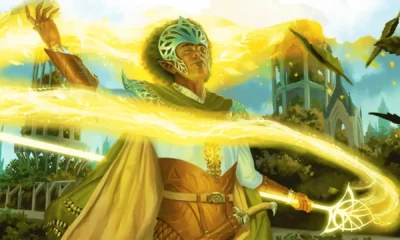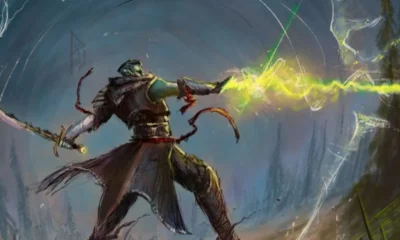Dungeons & Dragons
Spike Growth 5e D&D Guide

Greetings, fellow adventurers! I’m Alex Hawthorne, a seasoned D&D enthusiast, and today I’m thrilled to delve into the verdant depths of nature magic and explore the formidable spell known as Spike Growth.
Imagine a wilderness of thorns and brambles, ready to ensnare and punish those who dare to trespass.
Spike Growth allows you to transform the very ground beneath your feet, creating a treacherous terrain that can deter enemies, protect your allies, and turn the tide of battle.
Let’s unravel the secrets of Spike Growth, a spell that combines the raw power of nature with strategic brilliance.
What is Spike Growth in D&D 5e?
Spike Growth is a 2nd-level transmutation spell in D&D 5th Edition that covers the ground with sharp spikes and thorns.
These natural hazards are concealed from view, making it difficult for creatures to detect the danger.
When creatures move through the area, they suffer piercing damage from the hidden spikes, creating an effective and deadly deterrent against trespassers.

How to Master the Power of Spike Growth:
Mastering Spike Growth requires careful planning, tactical positioning, and an understanding of enemy movements.
Here’s how you can utilize this spell to its fullest potential:
- Area Denial: Cast Spike Growth in chokepoints, doorways, or areas where you anticipate enemy movement. This creates zones of control, limiting enemy mobility and forcing them to reconsider their approach.
- Strategic Retreat: Use Spike Growth as a defensive measure when retreating from enemies. Casting the spell behind you can slow down pursuers, giving you and your allies valuable time to escape to safety.
- Coordination with Allies: Communicate with your party members to ensure they are aware of the spike-covered area. Coordinate your movements and attacks, allowing your allies to lure enemies into the hazardous terrain, maximizing its effectiveness.
- Disrupting Enemy Formations: Spike Growth can disrupt enemy formations, forcing them to spread out or take alternate routes. This can scatter their ranks, making them vulnerable to focused attacks or area spells.
- Creative Uses: Think creatively about how Spike Growth can be used in different environments. In outdoor settings, it can blend seamlessly with natural foliage, making it even more challenging for enemies to discern the hazardous terrain.
Rules for Using Spike Growth:
- Spell Level: Spike Growth is a 2nd-level transmutation spell, which means you need to be at least a 3rd-level spellcaster (such as a 3rd-level druid or wizard) to cast it.
- Casting Time: Spike Growth has a casting time of 1 action. This means it takes your character one full action to cast the spell.
- Range: The spell has a range of 150 feet. You can cast Spike Growth on a point within this range.
- Area of Effect: The spell covers a 20-foot radius centered on the point you choose within range. The area becomes difficult terrain for the duration of the spell.
- Difficult Terrain: The area affected by Spike Growth becomes difficult terrain for the duration. This means that any creature moving through the area must spend 4 feet of movement for every 1 foot it moves.
- Concealed Spikes: The spikes created by Spike Growth are concealed and blend with the natural terrain. A creature that can’t see the area at the time the spell is cast must make a Wisdom (Perception) check against your spell save DC to recognize the terrain as hazardous before entering it.
- Piercing Damage: When a creature moves into or within the area, it takes 2d4 piercing damage for every 5 feet it travels. For example, if a creature moves 10 feet within the area, it takes 4d4 piercing damage.
- Duration: Spike Growth lasts for a duration of 10 minutes, allowing you to control the battlefield for an extended period.
- No Saving Throw: The damage from Spike Growth occurs automatically when a creature moves through the area, and there is no saving throw to reduce the damage.
- Non-Discriminatory: Spike Growth affects all creatures, regardless of their alignment or affiliation. This includes both allies and enemies, so careful positioning is essential to avoid damaging your own party members.
Examples of Spike Growth Usage:
Imagine your party is defending a narrow bridge against a horde of marauding bandits. Anticipating the attack, you cast Spike Growth on the bridge, covering the entire surface with concealed thorns.
As the bandits charge across the bridge, they unknowingly step into the trap. The hidden spikes pierce their boots, slowing them down and causing chaos among their ranks.
Your party, safely positioned behind the hazardous terrain, pelts the disoriented bandits with ranged attacks, easily repelling the invasion.
In another scenario, you’re exploring a dense forest infested with hostile creatures. To create a defensive perimeter around your campsite, you cast Spike Growth in a wide circle.
As night falls, a pack of wolves attempts to approach your campsite silently. The moment they step into the spike-covered area, their howls of pain alert your party, allowing you to prepare for the incoming attack.
The wolves, hindered and injured by the spikes, are no match for your well-prepared defenses.
Frequently Asked Questions (FAQs) about Spike Growth in D&D 5e:
Q: Can Spike Growth be cast on any surface, including indoor floors or stone surfaces?
A: Yes, Spike Growth can be cast on any surface, but its effectiveness may vary. On soft ground or natural terrain, the spikes can blend in, making them harder to detect. On hard surfaces like stone, the spikes might be more visible, potentially alerting creatures to the hazard.
Q: Does Spike Growth affect flying creatures or creatures on elevated platforms?
A: No, Spike Growth covers the ground with spikes. It does not affect flying creatures, creatures floating above the ground, or creatures on elevated platforms out of reach of the spikes.
Q: Can Spike Growth be used underwater or in environments with little or no soil?
A: Spike Growth is most effective in environments with natural soil or soft ground. It may not be as effective underwater or in areas with rocky terrain or sparse soil.
Q: Can creatures with keen senses detect Spike Growth without triggering it?
A: Creatures with keen senses, such as keen smell or keen hearing, might have an advantage in detecting the Spike Growth hazard. However, they still need to actively search for it and succeed on a Wisdom (Perception) check to notice the concealed spikes.
Q: Can Spike Growth damage creatures that move through the area at a fast pace, such as a rogue using the Dash action?
A: Yes, Spike Growth’s damage triggers when creatures move through the area, regardless of their movement speed. Creatures moving quickly, such as through the Dash action, still take damage if they pass through the spell’s area.
Armed with the natural hazards of Spike Growth, you can control the battlefield, protect your allies, and deter enemies with a thorny defense.
May your enemies tread carefully, your allies fight fiercely, and your adventures be filled with strategic victories amidst the wilds.
Safe travels, and may your spells always find their mark!

-

 Dungeons & Dragons7 months ago
Dungeons & Dragons7 months agoAberrations 5e D&D Guide
-

 Dungeons & Dragons6 months ago
Dungeons & Dragons6 months agoHeavy Crossbow 5e D&D Guide
-

 Dungeons & Dragons6 months ago
Dungeons & Dragons6 months agoUnderstanding Size Categories in Dungeons & Dragons Guide
-

 Dungeons & Dragons6 months ago
Dungeons & Dragons6 months agoMinor Illusion 5E D&D Guide
-

 Dungeons & Dragons7 months ago
Dungeons & Dragons7 months agoHerbalism Kit 5e D&D Guide
-

 Dungeons & Dragons7 months ago
Dungeons & Dragons7 months agoThaumaturgy 5e D&D Guide
-

 Dungeons & Dragons6 months ago
Dungeons & Dragons6 months agoRay of Sickness 5e Dungeons & Dragons Guide
-

 Dungeons & Dragons6 months ago
Dungeons & Dragons6 months agoLight Crossbow 5e D&D Guide
